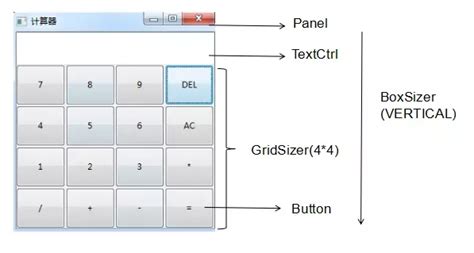简单的计算器
int i; char temp; double result[100],dotvalue=0; for (i=0;i<100;i++) result[i]=0; int ceng=50,dot=0,dotnum=0,type=0,type1=0,ji=0; for (i=0;i
这是我编写过的一个计算器代码,是直接通过文本框输入算式的那种,你给成按一个键输一个的是一样的。有什么问题可以交流。
简易计算器
加,减,乘,你应该用#define 定义一个简单的字符来表示, scanf("%s",&a),这个s建议写成c,其次,数据和对应的运算符(+ – *)只要倒过来运算就可以了,用一个%把对应的数组下表转换一下就可以了,你这写的太复杂,大家都不想看
编写简单计算器
#include “stdio.h”
#include “ctype.h”
#include “stdlib.h”
void main (){
int j,i=0,n=0;
double flag,sum=0,buffer;
char sign=’+’,str[50],*p;
gets(str);
while(str[0] != ‘0’) {
do{
j=i;
while(isdigit(str[i++])||str[i]==’.’) n++;
flag = str[i-1];
str[i-1]=’\0′;
p=&str[j];
switch(sign){
case ‘+’: if(str[i]==’*’||str[i]==’/’) buffer = atof(p);
else sum+=atof(p);
break;
case ‘-‘: if(str[i]==’*’||str[i]==’/’) buffer = -atof(p);
else sum-=atof(p);
break;
case ‘*’: if(str[i]==’*’||str[i]==’/’) buffer*=atof(p);
else{
buffer*=atof(p);
sum+=buffer;
}
break;
case ‘/’: if(str[i]==’*’||str[i]==’/’) buffer/=atof(p);
else{
buffer/=atof(p);
sum+=buffer;
}
break;
}
if(flag!=’ ‘) break;
sign=str[i++];
}while(i++);
if(n) printf(“%.2f\n”,sum);
sum=0;
buffer=0.0;
sign=’+’;
i=0;
n=0;
gets(str);
}
}
什么是 简易计算器
一个简单到只有最基础运算的计算器吧.
设计一个简单的计算器。
给你这个你应该就会全部了
#include
//===========================================调用阶乘算法=============
long keven(int n)
{
if (n<0)
printf(“输入错误!”);
//a=-1;
else if (n==0)
return 1 ;
else
return n*keven(n-1);
}
//====================================================================
long main()
{ float a,b,c;
float m,n;
printf(“请选择功能!\n”);
printf(“0代表退出!\n”);
printf(“1代表加法!\n”);
printf(“2代表减法!\n”);
printf(“3代表乘法!\n”);
printf(“4代表除法!\n”);
printf(“5代表阶乘!\n”);
while (1)
{
scanf(“%f”,&a);
if(a==0)
return 0;
if (a==1)
{
scanf(“%f%f”,&b,&c);
printf(“%f+%f=%f”,b,c,b+c);
// break;================如果加上break的话执行一次算法之后就退出来了!=========
}
if (a==2)
{ scanf(“%f%f”,&b,&c);
printf(“%f-%f=%f”,b,c,b-c);
}
if (a==3)
{
scanf(“%f%f”,&b,&c);
printf(“%f*%f=%f”,b,c,b*c);
}
if (a==4)
{
scanf(“%f%f”,&b,&c);
if (c!=0)
{
printf(“%f/%f=%f”,b,c,b/c);
}
else printf(“输入错误!”);
}
if(a==5)
{
int n;
scanf(“%d”,&n);
printf(“%d的阶乘是%ld”,n,keven(n));
}
}
}
用Visual Basic 语言怎样编写简单计算器(记事本 )
Private Sub cmdcalc_Click()
If opernum < 2 Then Exit Sub
Select Case opersymbol
Case 0
num1 = num1 + num2
Case 1
num1 = num1 – num2
Case 2
num1 = num1 * num2
case3
If num2 <> 0 Then
num1 = num1 / num2
Else
MsgBox “除数不能为0”
End If
End Select
opernum = 1
isnumber = True
str2 = “”
str1 = Str(num1)
txtresult = str1
End Sub
Private Sub cmdclear_Click(index As Integer)
Select Case index
Case 0
If opernum = 1 And isnumber And Len(str1) > 0 Then
str1 = Left(str1, Len(str1) – 1)
num1 = Val(str1)
txtresult = str1
elself isnumber And opernum = 2 And Len(str2) > 0
str2 = Left(str2, Len(str2) – 1)
num2 = Val(str2)
txtresult = str1 + str2
End If
Case 1
If isnumber And opernum = 1 Then
str1 = “0”
num1 = 0
txtresult = str1
elself isnumber And opernum = 2
str2 = “”
num2 = 0
txtresult = Str(num1)
opernum = 1
End If
Case 2
txtresult = “0”
str1 = “”
str2 = “”
num1 = 0
num2 = 0
opernum = 1
End Select
End Sub
Private Sub cmddot_Click()
If isnumber Then
If opernum = 1 Then
If InStr(string1, “.”) = 0 Then
str1 = str1 + “.”
txtresult = str1
End If
ElseIf opernum = 2 Then
If InStr(str2, “.”) = 0 Then
str2 = str2 + “.”
txtresult = str1 + str2
End If
End If
End If
End Sub
Private Sub cmdnumber_click(index As Integer)
If isnumber Then
If opernum = 1 Then
str1 = str1 + Right(Str(index), 1)
num1 = Val(str1)
txtresult = str1
ElseIf opernum = 2 Then
str2 = str2 + Right(Str(index), 1)
num2 = Val(str2)
txtresult = str1 + str2
End If
ElseIf Not isnumber Then
isnumber = ture
str1 = str1 + str2 + “”
opernum = 2
num2 = index
str2 = Right(Str(num2), 1)
txtresult = str1 + str2
End If
End Sub
Private Sub cmdoperate_click()(index As Integer)
If isnumber And opernum = 1 Then
isnumber = False
opernum = 2
ElseIf isnumber And opernum = 2 Then
Call cmdcalc_Click
isnumber = False
End If
str2 = “” = cmdoperate(index).Caption
txtresult = str1 + str2
opersymbol = index
End Sub
Private Sub form_load()
opernum = 1
isnumber = True
str1 = “”
str2 = “”
num1 = 0
num2 = 0
txtresult = “”
End Sub
编写一个简单的计算器
楼上不错.完整的应该加上头文件 #include
如何用vb编写简单计算器
Option Explicit
Dim Op1, Op2 ‘ 前面输入的操作数
Dim DecimalFlag As Integer ‘ 小数点仍然存在吗?
Dim NumOps As Integer ‘ 操作数个数
Dim LastInput ‘ 指示上一次按键事件的类型
Dim OpFlag ‘ 指示未完成的操作
Dim TempReadout
‘ C (取消) 按钮的 Click 事件过程
‘ 重新设置显示并初始化变量
Private Sub Cancel_Click()
Readout = Format(0, “0.”)
Op1 = 0
Op2 = 0
Form_Load
End Sub
‘ CE (取消输入) 按钮的 Click 事件过程
Private Sub CancelEntry_Click()
Readout = Format(0, “0.”)
DecimalFlag = False
LastInput = “CE”
End Sub
Private Sub Command2_Click()
End Sub
‘ 小数点 (.) 按钮的 Click 事件过程
‘ 如果上一次按键为运算符,初始化 readout 为 “0.”;
‘ 否则显示时追加一个小数点
Private Sub Decimal_Click()
If LastInput = “NEG” Then
Readout = Format(0, “-0.”)
ElseIf LastInput <> “NUMS” Then
Readout = Format(0, “0.”)
End If
DecimalFlag = True
LastInput = “NUMS”
End Sub
Private Sub drjsb_Click()
If Readout <> “0” And Readout <> “0.” Then
Form1.Text1.Text = Form1.Text1.Text & Readout
Form1.Text1.SelStart = Len(Form1.Text1.Text)
Form6.Hide
End If
End Sub
‘ 窗体的初始化过程
‘ 设置所有变量为其初始值
Private Sub Form_Load()
DecimalFlag = False
NumOps = 0
LastInput = “NONE”
OpFlag = ” “
Readout = Format(0, “0”)
‘Decimal.Caption = Format(0, “.”)
End Sub
‘ 数字键 (0-9) 的 Click 事件过程
‘ 向显示中的数追加新数
Private Sub Number_Click(Index As Integer)
If LastInput <> “NUMS” Then
Readout = Format(0, “.”)
DecimalFlag = False
End If
If DecimalFlag Then
Readout = Readout + Number(Index).Caption
Else
Readout = Left(Readout, InStr(Readout, Format(0, “.”)) – 1) + Number(Index).Caption + Format(0, “.”)
End If
If LastInput = “NEG” Then Readout = “-” & Readout
LastInput = “NUMS”
End Sub
‘ 运算符 (+, -, x, /, =) 的 Click 事件过程
‘ 如果接下来的按键是数字键,增加 NumOps。
‘ 如果有一个操作数,则设置 Op1。
‘ 如果有两个操作数,则将 Op1 设置为 Op1 与
‘ 当前输入字符串的运算结果,并显示结果
Private Sub Operator_Click(Index As Integer)
TempReadout = Readout
If LastInput = “NUMS” Then
NumOps = NumOps + 1
End If
Select Case NumOps
Case 0
If Operator(Index).Caption = “-” And LastInput <> “NEG” Then
Readout = “-” & Readout
LastInput = “NEG”
End If
Case 1
Op1 = Readout
If Operator(Index).Caption = “-” And LastInput <> “NUMS” And OpFlag <> “=” Then
Readout = “-“
LastInput = “NEG”
End If
Case 2
Op2 = TempReadout
Select Case OpFlag
Case “+”
Op1 = CDbl(Op1) + CDbl(Op2)
Case “-“
Op1 = CDbl(Op1) – CDbl(Op2)
Case “X”
Op1 = CDbl(Op1) * CDbl(Op2)
Case “/”
If Op2 = 0 Then
MsgBox “除数不能为 0”, 48, “计算器”
Else
Op1 = CDbl(Op1) / CDbl(Op2)
End If
Case “=”
Op1 = CDbl(Op2)
Case “%”
Op1 = CDbl(Op1) * CDbl(Op2)
End Select
Readout = Op1
NumOps = 1
End Select
If LastInput <> “NEG” Then
LastInput = “OPS”
OpFlag = Operator(Index).Caption
End If
End Sub
‘ 百分比键 (%) 的 Click 事件过程
‘ 计算并显示第一个操作数的百分数
Private Sub Percent_Click()
Readout = Readout / 100
LastInput = “Ops”
OpFlag = “%”
NumOps = NumOps + 1
DecimalFlag = True
End Sub
C语言实现的简易计算器
展开全部
#include
void main()
{
float a,b,i=0;
char yun;
mama: printf(“\n请输入运算符和要计算的两个数:”);
main:if(i<3)
{
fflush(stdin);
scanf(“%c%f%f”,&yun,&a,&b);
switch(yun)
{
case ‘+’:printf(“%.2f+%.2f=%.2f”,a,b,a+b);
break;
case ‘-‘:printf(“%.2f-%.2f=%.2f”,a,b,a-b);
goto mama;
case ‘*’:printf(“%.2f*%.2f=%.2f”,a,b,a*b);
goto mama;
case ‘/’:printf(“%.2f/%.2f=%.2f”,a,b,a/b);
goto mama;
default:i++;
{ if(i==3)
printf(“\n您已经三次输入不正确:谢谢使用…再见!”);
else
printf(“您的输入有误\n请从新输入:”);
goto main;
}
}
printf(“\n谢谢使用…再见!”);
}
}
1。编写简单计算器
#include using namespace std; double cal(double a, double b, char ch); int main() { double a = 0, b = 0; char ch; double result = 0; while(true ) { cin >> b >> ch; a = cal(a, b, ch); } return 0; } double cal(double a, double b, char ch) { switch(ch) { case(‘q’): { cout << endl << "end of calculations"; exit(0); } case('s'): { cout << endl << "=" << b << endl; return b; } case('+'): { cout <<< "=" << a + b << endl; return a + b; } case('-'): { cout <<< "=" << a - b << endl; return a - b; } case('*'): { cout <<< "=" << a * b << endl; return a * b; } case('/'): { if ( b != 0 ) { cout <<< "=" << a / b << endl; return a / b; } else { cerr << endl << "输入错误,0不能作为被除数!"; exit(0); } } default: { cerr << endl << "输入错入"; exit(0); } } }








